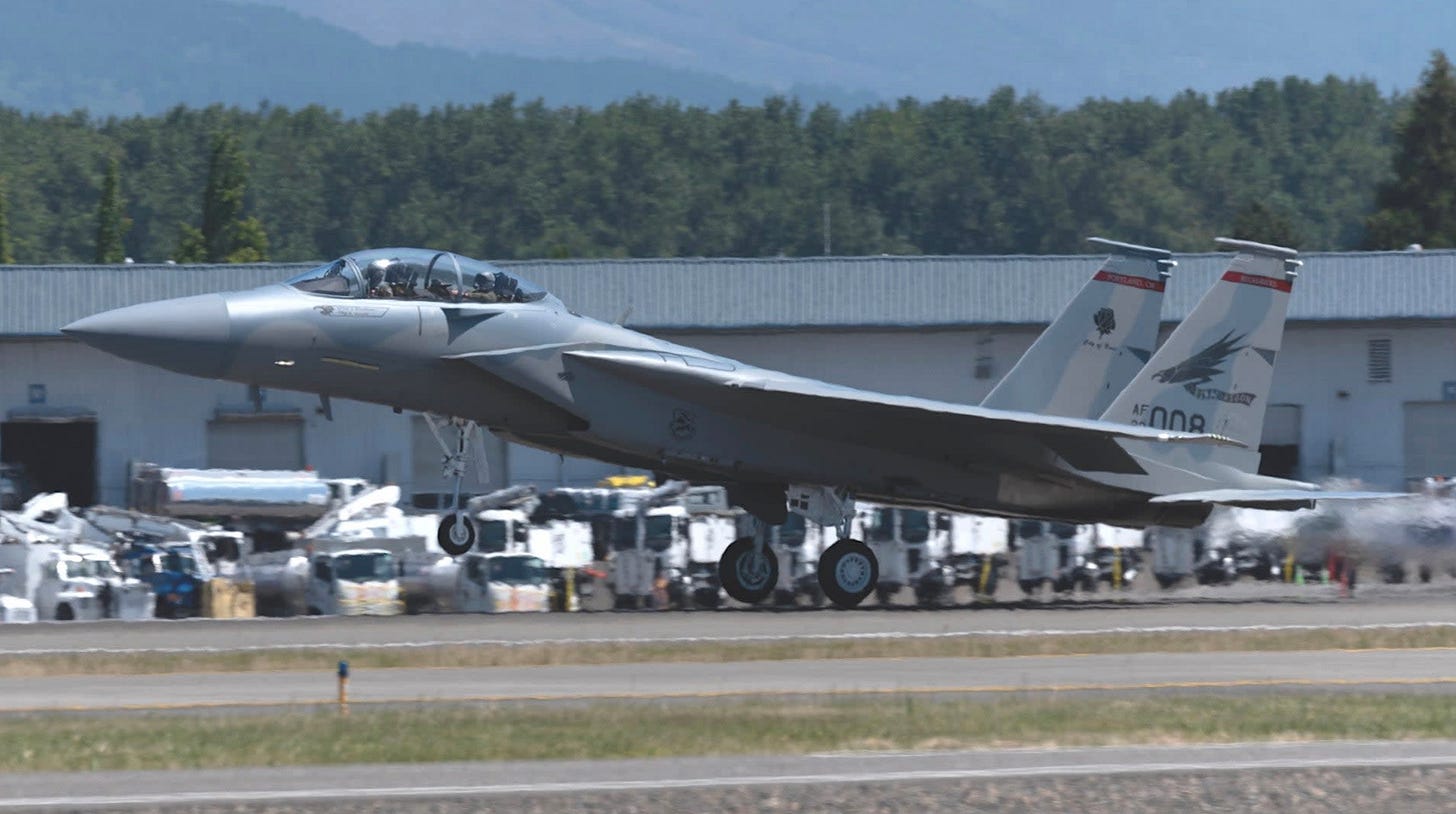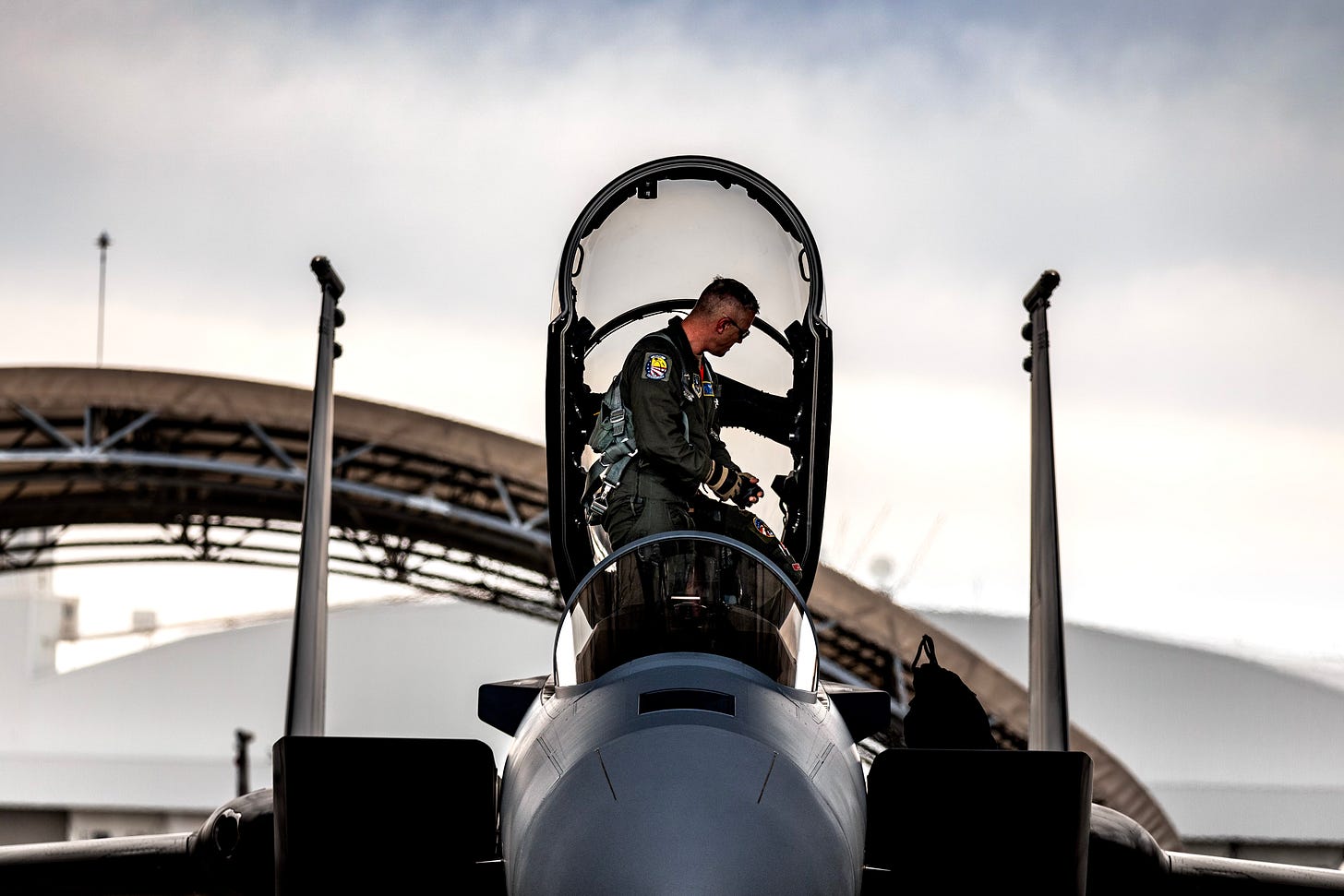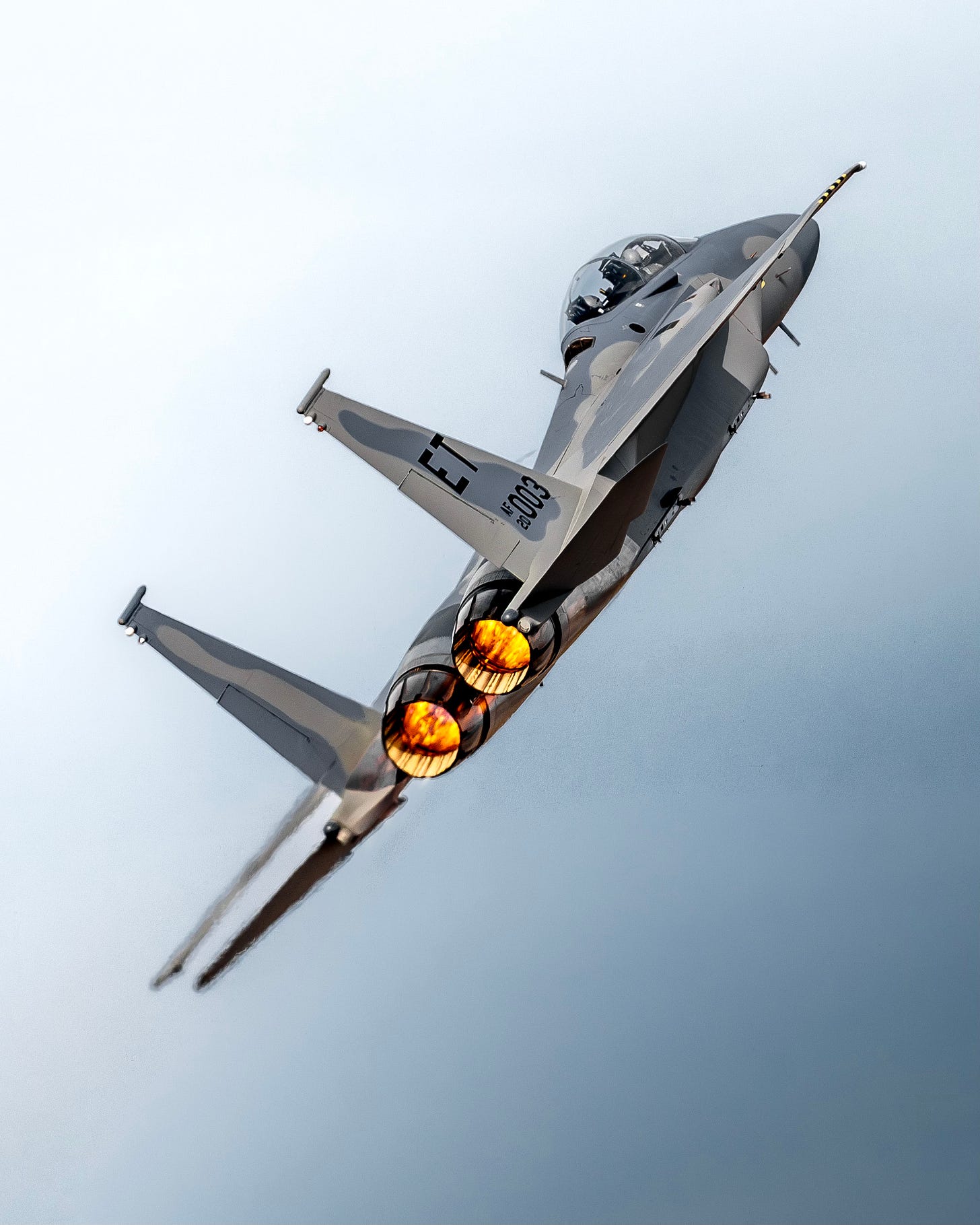The F-15EX and the Burden of Platform Culture
How cultural status quo and resistance to change could hinder one of America's greatest combat assets before it’s even operational.
“Do not let what you fly define who you are.”
My dad, a retired F-4E and A-10 pilot, shared these words with me in college after I told him I wanted to follow in his footsteps and fly fighter jets in the United States Air Force: “Do not let what you fly define who you are.” Twenty-three years since that conversation, 18+ years active duty and 2200+ hours flying F-15E/EX/SA/QA, these words ring more true now than ever.
The F-15EX “Eagle II” (unofficially christened “Phoenix”) represents a significant advancement in fighter aviation, transcending mere platform replacement to offer unprecedented capabilities for delivering decisive effects on the battlefield. By prioritizing a forward-thinking approach worthy of the Phoenix name, focused on delivering effects rather than fielding a platform, we will fully harness the potential of EX to enhance national security and ensure its successful integration into the Air National Guard, the United States Air Force, and broader military operations.

Platform or Effects?
As we seek to add new arrows to the nation’s quiver and provide greater options to the combatant commanders, we must focus on effects, not platform.
The F-15E Strike Eagle is one of, if not the most capable and successful fighters in history. The EX builds upon that legacy: Mach 2.5, 9G+, 12x AMRAAM with extreme maneuverability, 12 advanced missiles and 3x JASSM (and maybe 5), hours of endurance, the best fighter radar, the most powerful mission computer, and a single-ship load-out greater than a 4-ship of F-35s — she is truly an apex predator. Yet the individual platform and these specific capabilities shouldn’t be the focus. What matters — the only thing that matters — is delivering timely and relevant effects to the battlespace. The platform itself holds little significance; the effects are consequential.
As we seek to add new arrows to the nation’s quiver and provide greater options to the combatant commanders, we must focus on effects, not platform. We have an opportunity as the new EX community to think outside the box, and pull from the very best of multiple communities to establish a new culture. We must not squander this once-a-generation opportunity by fixating on old ways of doing business.
At all levels of warfare — tactical, operational, and strategic — it really doesn’t matter what we procure if we can generate the effects we need, when we need them. If I could send a Cessna 152 to successfully take down an HQ-9 system or Gravestone radar, I would. I don’t care what it looks like, smells like, what color it is, what it is named, or how many people are in it. If it delivers the required kinetic or non-kinetic effects in or on the battlefield, send it.
Christian Brose is justifiably critical of platform-centric acquisitions and military cultures in his book “The Kill Chain.” His criticisms of military leadership and culture include:
“We generate our military requirements for military power in terms of platforms.
We build our budgets and spend our money on the basis of platforms.
We define our goals for military capability in terms of platforms.
Platforms often rise to the level of defining the very identities of our military institutions and the men and women who comprise them.
Leaders too often seem to lose sight of the larger objective… the reason why we would want any platforms to begin with.”
EX is not a C-model replacement, nor is it an E-model replacement. EX is not a platform replacement. It is an effect delivery method with an incredible cost-per-effect ratio due to the number of weapons it can employ on a single mission, compared to other similarly agile fighter assets (F-16, F-35, F-22, etc). Phoenix, as an effect, can combine with numerous other effects to break the will of our adversaries, reshaping the battlespace to one that will suit our desires in order to deter, or if necessary, win any conflict. We should not box ourselves into thinking anything less of EX.
The Politics of a Name
“We could not have done what we did without the WSO.”
There is no aircraft called the “F-15X,” nor is there a program of record with that name in the Department of Defense (DoD). Intentionally referring to it as an “X” to further a culture-driven narrative that mentally and verbally isolates EX from the F-15E is unserious. I might expect that from a new LT, pumped up and motivated as a new fighter pilot, but not from senior leaders. The “not a pound for air to ground” mindset must depart with the last C-model to the boneyard, as it has the potential to influence — and already might be influencing — more than just the weapons load-out for EX.
Currently, there exists a large pool of highly talented Weapons System Officers (WSO) in the USAF. These aircrew have more combat time, more recent and numerous air-to-air (A/A) kills, and have removed more enemies of freedom from the battlefield over the last 35 years than all modern air superiority units, combined. Those WSOs have a role to play in EX. If the WSO offered an insignificant benefit to EX with a negative cost/benefit, I would call for the dissolution of the 12F career field after the inevitable (future) F-15E divestiture. Fortunately for the nation, this is not the case. The WSO is a force multiplier, now and in the future, and EX is the delivery method.
Lt Col Curtis “Voodoo” Culver, one of the squadron commanders from the April 2024 counter-drone defense of Israel, told me the day after, “we could not have done what we did without the WSO.” The task of managing multiple sensors, employing a radar that sees everything, talking/listening on three radios, and keeping track of swarms of drones and cruise missiles, all while shaping the battle-space in a organized, highly professional and concerted effort to provide a manageable picture for PATRIOT, NASAMS, or other ground-based air defenses is, difficult. Yet, this is a mission tailor-made (among many other missions) for the crewed EX. Throw a few JASSM shots or a half-dozen SDBII retargeting efforts in there, and you have yourself a party.
The above is an incredible amount for one person to manage in a tactical scenario, with a high chance of task saturation. If we truly want to exploit current and future capabilities as well as create new TTPs to further enhance the effects of EX, we must not let this new platform serve only to embolden egos. The ANG F-15C units fielding EX can and must figure out how to incorporate the multi-mission, half-century long corporate knowledge and expertise in air-to-ground (A/G) and multi-role/mission that the WSO brings. As we merge these two communities and cultures, C and E, we can and must find new and better ways of doing business as we compete against, deter, and prepare to defeat our nation’s greatest adversary in history — even if that includes flying with a WSO.
But, ACA, F-35 and F-16!
…the F-15E community trains for and is ready to execute the entire portfolio…
While Aerospace Control Alert (ACA) and homeland defense are of course critical to national security, they should represent only a sliver of the picture for ANG squadrons fielding EX. If I were to recapitalize an ANG A-10C squadron with F-15EX, I would expect them to undertake more than Close Air Support (CAS) and Combat Search and Rescue (CSAR). I would expect them to be hungry to learn how to do more than CAS and CSAR, and I would expect them to be willing to learn how to fully exploit EX capabilities from any expert in that field… pilot or WSO. Anything less and we will have achieved nothing more than overpaying for an iron-swap. In an already budget-constrained environment, this is not an acceptable course of action.
Some might point to the F-35 or the F-16 as an example of a successful single-seat, multi-role fighter aircraft — and they would be right. Those aircraft have the technical ability to do pretty much all the things that any multi-role fighter can do. Aside from smaller payload and fuel capacity, which the F-15E and EX substantially exceeds on both, the Fighting Falcon and Lightning II boasts a great deal of multi-role capability and are impressive on paper. However, those communities (especially the F-16 community with numerous variants or “Blocks”), manage those mission requirements for their wings and squadrons substantially different from the way they are managed for F-15E.
Because of factors such as total operational jets, pilot workload, pilot-vehicle interface (PVI), available sorties, training time, personnel, flying hour program, and many other variables, F-16 squadrons specialize in a particular mission (SEAD/DEAD, homeland defense, etc). In contrast, the much smaller F-15E community has a much lower cost-per-effect, as each squadron trains for and is ready to execute the entire portfolio of capabilities that the aircraft itself is capable of. This tradecraft was recently tested and proven in a real-time flex from traditional CAS to Defensive Counter Air (DCA) — at scale — with outstanding, POTUS-praised success.
The F-35 and F-16 truly are amazing aircraft and technological marvels. However, the cost to get two missiles and two bombs airborne on one F-35 or one F-16 (with a few more missiles) is effectively the same as a single F-15EX loaded with 3 or 5 x JASSM, for example, and 12 or 8 x AMRAAM (roughly $27,000 per EX hour, $35,000 per F-35 hour). Basic math puts an airborne AMRAAM on an EX at $2,250 per hour, but the same AMRAAM on an F-35 is $17,500 per hour. In the budget constrained environment where stealth is not as critical as long-range kill chain and bringing weapon effects at affordable scale, the EX is a major win for the combatant commander. Clearly, the cost-per-effect goes down with every EX that gets airborne.
High Demand, Low Density… Again
…100% of EX effects available on night one.
Although I wasn’t in the room 35 years ago when USAF leadership made these decisions, this “jack of all trades” approach with F-15E was likely due to the high-demand/low-density nature of the jet, the fact that many initial cadre came from F-4 and F-111 squadrons, and the decades-old TTPs to divide and conquer at the tactical level between the pilot and WSO. Leadership likely designed the decisions of basing, missions, doctrinal statements, etc., around 2-seat fighter employment of less than 150 combat coded jets across the entire Combat Air Forces (CAF). If we had purchased 500 F-15E, perhaps we would have designed the operational employment around specific mission-focused squadrons, or perhaps even flown/employed some F-15E single-seat squadrons in a primarily air-to-air mission set. But we didn’t buy 500.
History is repeating itself, as it tends to do. Due to budgetary issues, we are not purchasing F-15EX in the quantities desired, let alone quantities required to differentiate unit-by-unit mission sets. If we were purchasing EX in the numbers we purchased F-16 or F-35, squadron-dependent mission specializations might make sense, as they would individually differ in skillsets but holistically showcase the true and total multi-mission nature of the platform. We do not have that luxury with EX. If we separate even just one F-15EX unit off to focus on a “single-seat mission” or even a paired-down mission set, we are severely missing the mark.
If homeland defense, and not multi-mission advanced capabilities, was your priority, the USAF would have been far better off sending older active duty 229-engine F-15E, stripped of CFTs, to the ANG units, while recapitalizing USAF and INDOPACOM with EX direct from the production line. With that course of action, you would have 100% of EX effects available on night one. If anything else — politics, budgets — was your priority, then fielding EX direct to ANG and calling it a “C-model replacement” makes sense. It is because the latter is the reality that I am compelled to write these words.
The Jedi Master
EX was born a Jedi Master.
Under the current NDAA and USAF plan, EX will recapitalize several F-15C ANG units and absolutely dominate in the homeland defense role. However, its similarities with a C-model end with the “F-15” name, and it should not be considered a “C-model replacement.” The Phoenix is an advanced, multi-role, simultaneous multi-mission, multi-domain fighter aircraft and effect delivery system with untold capabilities. Treating it as an iron-swap for the F-15C sells it roughly 90% short, and does a great disservice to our nation.
Dick Jonas once sang of the F-15E, “I was a 4th degree genius the day I was born,” thanks to the established F-15A-C and F-4E TTPs. The fledgling F-15E Weapons School was able to quickly build upon these TTPs, as the first F-15E pilots and WSOs rushed to Operation Desert Storm. It was in that conflict that the Strike Eagle cut her teeth, and famously earned her first air-to-air kill, fittingly with a bomb guided by the WSO.
With this as the benchmark — 50+ years of refined A/A TTPs and 35 years of multi-mission and A/G TTPs — EX was born a Jedi Master.
Of course, two things can be true at the same time. It is entirely possible to employ the F-15EX single-seat, and execute some C-model-esque air-to-air and basic bomb on coordinate (BOC) A/G missions successfully. However, because we are currently sitting at 98 EX in the current NDAA, we need every EX we buy ready to execute the full compliment of capabilities and effects on night one, enabled by the crewed-mission of the Strike Eagle and 35 years of vetted TTPs from that community.
So what is the answer? Well — of course — it depends. The answer is very likely a hybrid approach — one that leverages the best of the C-model (for air-to-air dominance) and E-model (for everything else) communities. In whatever scenario resolves for an operational EX, the strategic vision should be incorporating EX into the “high-low” mix and ensuring each EX squadron brings full EX capabilities to whatever area of responsibility (AOR) they deploy to.
Conclusion
The true measure of the F-15EX lies in the effects it delivers to, on, and in the battlefield. Enhanced by decades of coordinated teamwork and advancements in technology, these effects transcend individual capabilities, platform cultures, and egos. Whether it’s multi-sensor simultaneous operation, advanced weapons edge-retargeting to obtain OODA point against an agile adversary, manned/unmanned teaming (MUM-T) and collaborative combat aircraft (CCA) control at scale, dominating the electromagnetic spectrum at the edge, enabling/enhancing long-range kill chain, or next generation air battle management and mission command at the edge, we must be ready to fully exploit the EX on night one. Easing our way in with EX might work if we were still hunting terrorists in caves, but not — NOT — when we are deterring a rising threat in the far east — the greatest military and geopolitical threat of our nation’s history.
Naturally, there will be a learning curve, both for the skills required and for the technologies to field. However, I humbly submit that if we do not immediately open our aperture, if we remain closed off to the truth that the EX is far more an Advanced Strike Eagle than the uninspired, politically chosen name “Eagle II” suggests, and if our new EX leadership sets a culture or even hints that “we don’t fly with WSOs”, our learning curve will be far, far larger than it needs to, or should, be.
We must get this right.

Re-attack/Epilogue
In 2016, I deployed in support of Operation Inherent Resolve (OIR) with the legendary 335th FS Chiefs (the very same legendary squadron who, along with the 494th FS Panthers, received praise from the White House over the defense of Israel). About halfway through our deployment, we had a never-before-deployed F-22A squadron show up to the fight. I greatly respected how their leadership and entire squadron approached joining “Strike Ops” — they arrived hungry and willing to learn from anyone in the squadron. The respect they showed those of us who knew nothing other than dropping bombs and executing the multi-mission F-15E for our entire USAF lives was excellent. They effectively said, “I know nothing about this A/G game — teach me.” They became better for having taken this approach. More importantly, we all did our jobs well, the missions succeeded and we furthered U.S. National Security.
I hope to see this same approach from the ANG squadrons blessed to be the first with EX. There is still time, and there are enough patriots involved in the fielding and operation of the first squadrons of EX, both in the USAF and ANG, to give me hope. We just need to listen to them.
Bottom Line On Bottom: Whether deploying the full capabilities of the F-15EX with WSOs or operating single-pilot for specific mission sets or traditional homeland defense sorties, what matters most is the cultivation of a new, forward-thinking F-15EX fighter culture, as part of a new, forward-thinking broader USAF vision. After all — Accelerate, Change, or Lose.
The future of EX, and yes — our nation — depends upon fully harnessing the potential of this new era in fighter aviation with the F-15EX Advanced Strike Eagle II Phoenix.
About The Author
Lt Col Matthew “Cain” Olde is an Evaluator and Acceptance Fighter Pilot in the F-15 Legacy and Advanced Eagles, with over 500 hours in Advanced Eagle and over 2200 total hours in F-15E/EX/SA/QA.





Excellent article, Cain! It’s 100% about the effects based approach and not about ego or “this is the way we did it in the E or C model communities” and you made the argument very well.